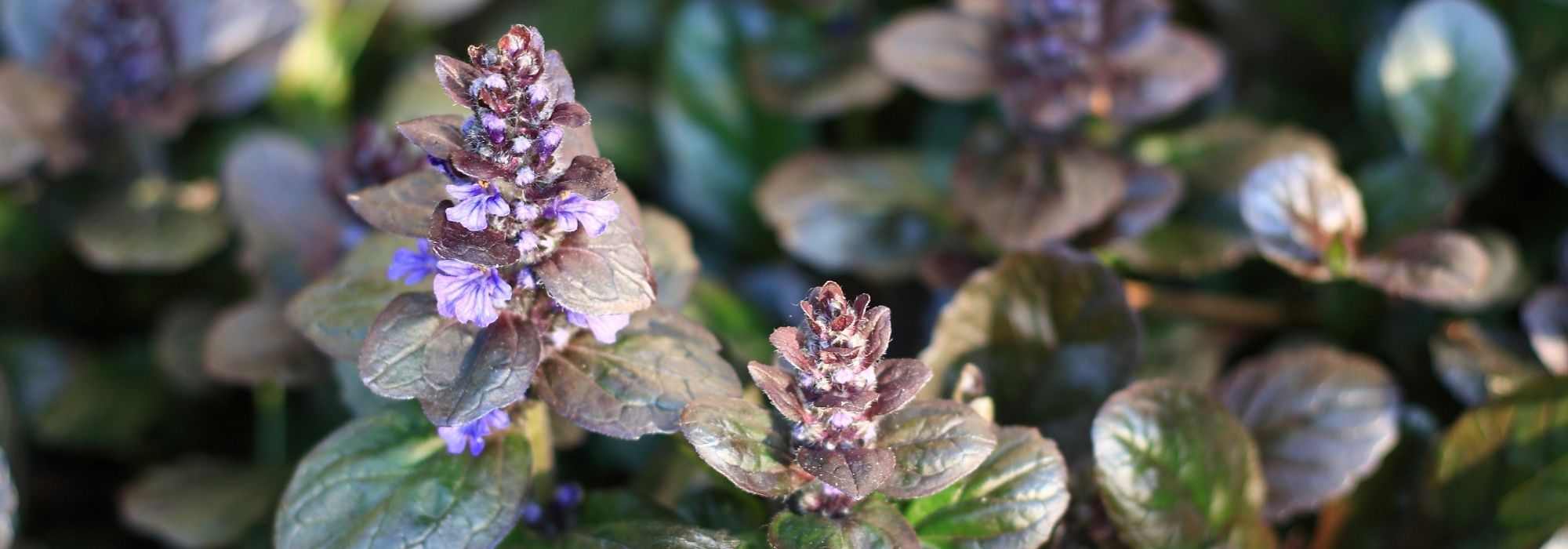
How to choose an ajuga?
Buying guide to find the ideal creeping bugle!
Contents
The ajuga or creeping bugle is a charming perennial ground cover plant with spring or summer flowering. One of its strengths lies in its beautiful foliage, which is generally evergreen, glossy, and varies in colour from dark green to purple, including lovely variegated varieties.
Thanks to its creeping stolons, it quickly creates a vibrant cushion at the base of trees, in the foreground of borders, on slopes, or in flowering pots.
Ajuga thrives in both partial shade and the shadiest corners of woodlands, in heavy, clay soils.
With various flower colours and shapes, flowering periods, foliage colours, sizes, and garden uses, let’s explore how to choose a creeping bugle based on these different criteria and find the perfect variety!
Choosing an ajuga based on flower colour
If the most common ajugas display a lovely blue-grey colour, also discover the pink or white varieties, which are equally charming.
Blue ajugas
Blue is the emblematic colour of ajugas. It comes in various shades, from the lightest to the darkest.
- The most common Ajuga reptans offers a typical dark blue-grey flowering, leaning towards violet
- ‘Catlin’s Giant’ features an intense blue
- ‘Variegata’ is adorned with violet-blue flower spikes
- The flowers of ‘Braunherz’ lean towards a bright violet
- Ajuga tenorii ‘Chocolate Chip (Valfredda)’ displays a very bright lavender blue
- Ajuga pyramidalis ‘Metallica Crispa’ treats us to a delicate pale blue
White ajugas
Equally bright and particularly easy to pair, white creeping bugles add a true delicate touch to the garden. This is the case with Ajuga reptans ‘Alba’ or ‘Sanne’, which showcase a beautiful pure white.
Pink ajugas
Less common, but still so lovely, pink-flowered creeping bugles will pair wonderfully with their blue sisters. Ajuga reptans ‘Purple Torch’ offers a true vibrant pink carpet, while the more delicate ‘Gold Chang’ presents a soft pastel pink leaning towards mauve.

Ajuga reptans ‘Braunherz’, Ajuga reptans ‘Sanne’ and Ajuga reptans ‘Purple Torch’
Read also
Ajuga : growing and careChoose an ajuga based on flower size
During flowering, ajugas are adorned with small whorled spikes (emerging at the same level). They consist of a multitude of flowers with a corolla featuring 2 lip-shaped lobes. Its tiny flowers develop along the stem.
In Ajuga pyramidalis, the flowers form thick pyramid-shaped spikes, which are quite uncommon.
The flowers generally reach 10 to 12 cm, but the largest can rise up to 20 cm. This is the case, for example, with ‘Catlin’s Giant’.

Ajuga reptans, Ajuga pyramidalis (photo color line) and Ajuga reptans ‘Catlin’s Giant’
Discover other Ajuga
View all →Available in 2 sizes
Available in 2 sizes
Available in 2 sizes
Available in 1 sizes
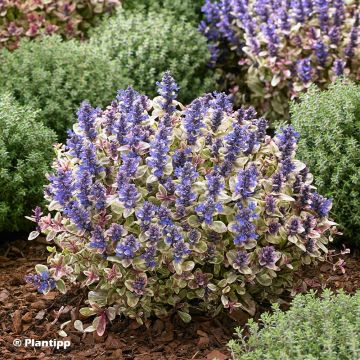
Available in 2 sizes
Available in 1 sizes
Available in 2 sizes
Available in 2 sizes
Available in 1 sizes
Available in 2 sizes
Choose an ajuga based on the flowering period.
The flowering of creeping bugle occurs between May and July and lasts for about one month. The flowers are rich in nectar and inevitably attract bees, bumblebees, and butterflies.
Among the spring-flowering varieties, between May and June, we can mention Ajuga incisa ‘Frosted Jade’, Ajuga tenorii ‘Dixie Chip’ or Ajuga reptans ‘Golden Glow’.
For summer-flowering cultivars, between late June and August, we find Ajuga pyramidalis ‘Metallica Crispa’, Ajuga reptans ‘Braunherz’, and Ajuga reptans ‘Multicolor (Rainbow)’.
Ajuga tenorii ‘Princess Nadia’ has the particularity of flowering in spring, then being perpetual at the end of summer, in September.
Read also
5 groundcovers for clay soilChoosing an ajuga based on foliage
The foliage of ajugas is particularly decorative. Most are evergreen, dressing the garden in light even during winter. Some are even dynamic, changing colours over time.
The leaves generally take the form of crinkled rosettes, except for Ajuga incisa ‘Frosted Jade’, whose green foliage variegated with white is deeply cut, almost incised. This adds a true graphic touch, but it is deciduous.
In Ajuga tenorii ‘Dixie Chip’, the tiny leaves variegated with green, cream, and purple are rather ovate, narrow, and elongated. Ajuga pyramidalis ‘Metallica Crispa’ offers an astonishing green-bronze foliage with a crisped appearance.
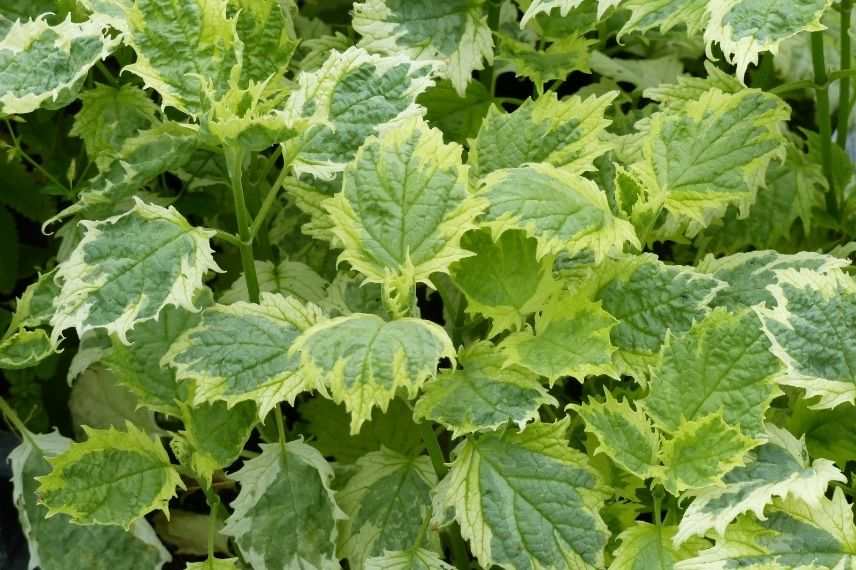
Ajuga incisa ‘Frosted Jade’
Green-leaved ajugas
The leaves of ‘Alba’ are adorned with a dark green hue with metallic reflections, while ‘Atropurpurea’ graces us with foliage that is green tinged with rose-purple.
‘Gold Chang’ features particularly bright foliage, a lime green leaning towards yellow or gold.
‘Catlin’s Giant’ offers long green leaves measuring 15 cm with bronze reflections.
Purple-leaved ajugas
The remarkable ‘Black Scallop’ boasts shiny foliage with bronze-chocolate hues, so dark that it sometimes appears black.
Ajuga tenorii ‘Chocolate Chip (Valfredda)’ features chocolate foliage during the coldest months, before turning green-purple.
Variegated-leaved ajugas
While they can sometimes be more challenging to pair, variegated foliage offers a spectacle that is hard to tire of.
Ajuga reptans ‘Variegata’ will illuminate every corner of the garden with its green foliage margined with cream.
Even more colourful, ‘Golden Glow’ features green foliage splashed with yellow, cream, and pink.
Ajuga reptans ‘Burgundy Glow’ delights us with foliage variegated with pink, bronze green, and cream white.
‘Multicolor (Rainbow)’ certainly lives up to its name, referring to its incredible dark green leaves with metallic reflections and splashed with purple, cream, and bright pink.

Ajuga reptans ‘Alba’, Ajuga reptans ‘Black Scallop’ and Ajuga reptans ‘Burgundy Glow’
Choosing an ajuga based on its size and use
Creeping bugles are small perennials that do not exceed 40 cm in height and 60 cm in spread. They are thus perfect for the edges of flower beds, to dress the base of trees or bushes, or to cover a bank.
Their small silhouettes also lend themselves very well to pot cultivation, hanging baskets, bowls, or planters, as with the compact and non-invasive variety Ajuga tenorii ‘Princess Nadia’.
Some varieties of creeping bugles have a particularly rapid growth, allowing them to quickly dress the corners of the garden, such as ‘Catlin’s Giant’. It is worth noting that varieties with variegated foliage are generally less vigorous than their counterparts.
On their part, some small cultivars can be used like grass or to brighten up a short grass meadow. This is the case with Ajuga tenorii ‘Chocolate Chip (Valfredda)’, which is only 8 cm tall, or Ajuga tenorii ‘Dixie Chip’, measuring 10 cm in height at ripeness. These bugles can indeed withstand occasional foot traffic and can be maintained with a simple mowing after the spring flowering.
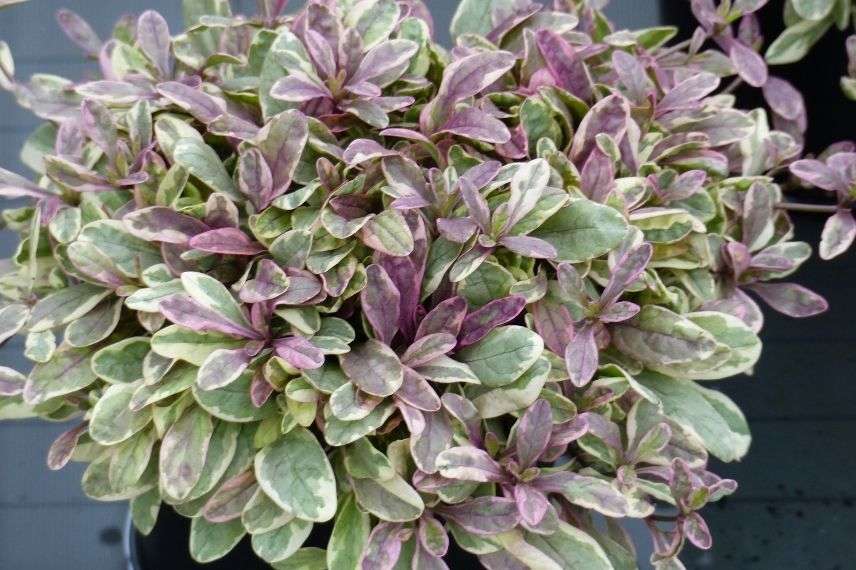
Thanks to its compact habit, Ajuga tenorii ‘Princess Nadia’ is ideal for pot cultivation
Choose an ajuga according to climate constraints
Drought Resistance
While aguja is a robust plant, tolerant of soil type, it is sensitive to scorching sun and drought, which can cause the foliage to wilt. It is therefore particularly challenging to grow in Mediterranean regions.
Ajuga pyramidalis ‘Metallica Crispa’ is, however, more drought-resistant than other varieties and will thrive in even poor, stony soil. The Geneva bugle can also tolerate temporary drought, but not extreme conditions.
The Hardiest Varieties
The creeping bugle naturally offers very good hardiness, ranging from -15°C to 20°C. Among the hardiest are ‘Golden Glow’, ‘Sanne’, and the ajugas tenorii.
- Subscribe!
- Contents
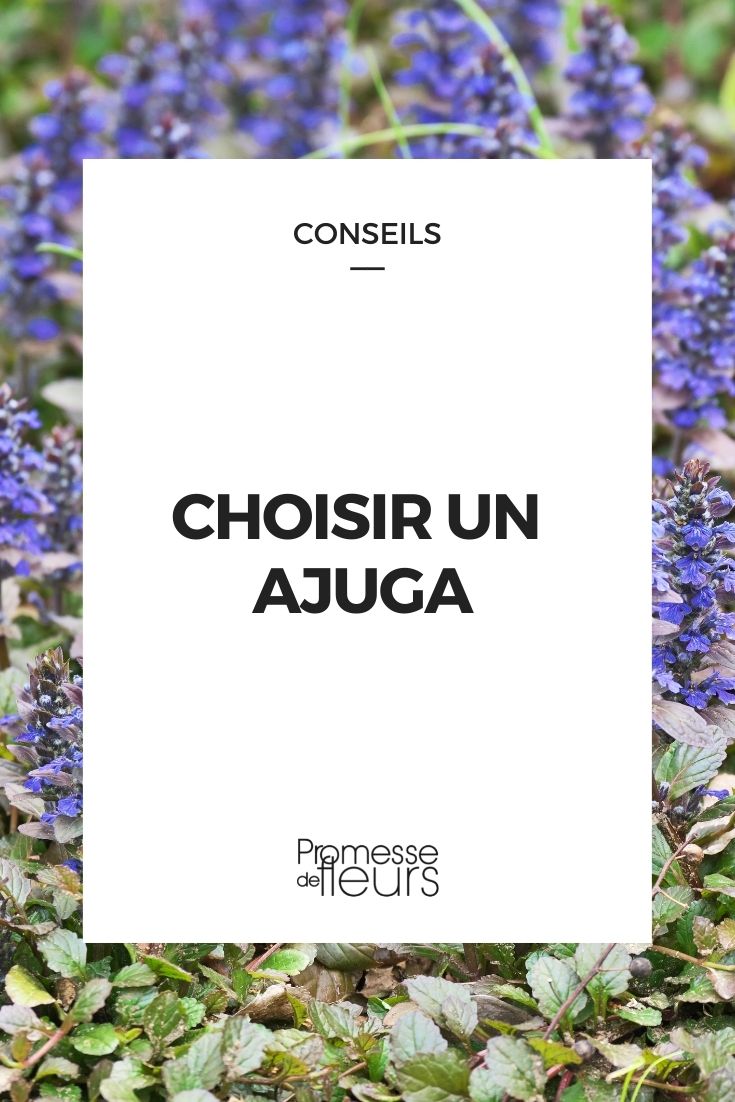































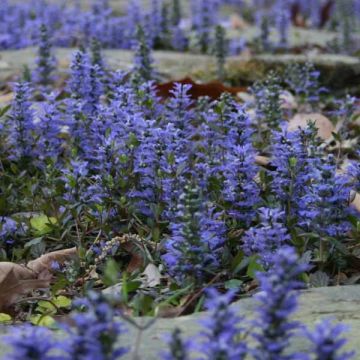
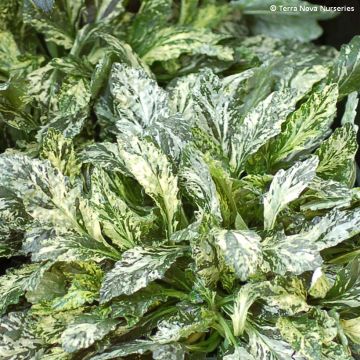
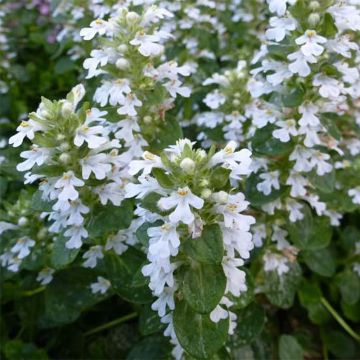
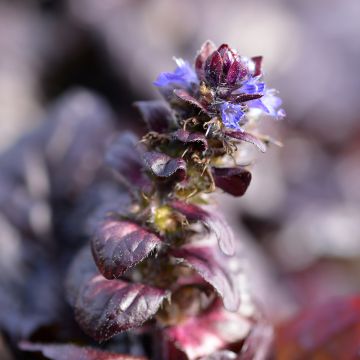
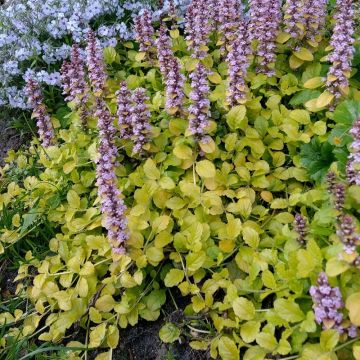
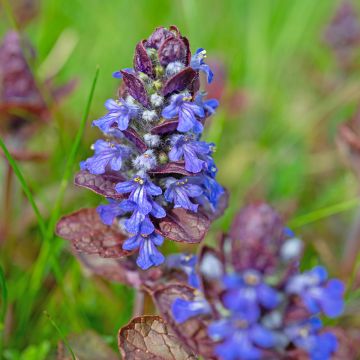
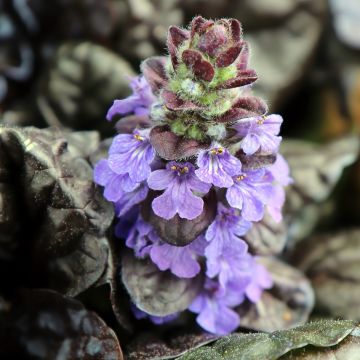
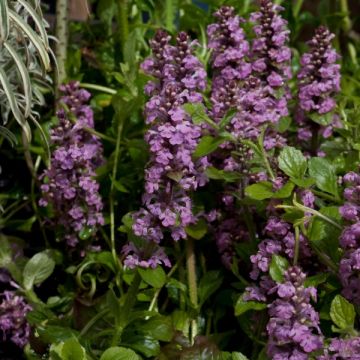
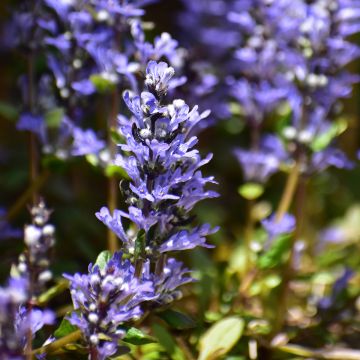
Comments